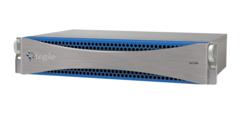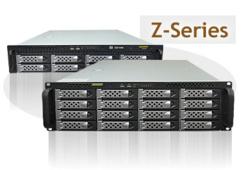
Newark, CA (PRWEB) August 14, 2012
Tegile Systems, a pioneer in primary storage de-duplication in virtualized server and desktop environments, today announced innovative enhancements to its high-availability MASS architecture and the extension of its product line with the addition of two new powerful storage arrays, the Zebi HA2400 and Zebi HA2800. Tegiles Metadata Accelerated Storage System (MASS) technology separates metadata from the primary data path and optimizes functions such as de-duplication, compression, RAID and snapshot pointers, allowing for up to 75% capacity savings, while accelerating IO by up to seven times when compared to traditional storage systems.
The major flaw we see in the all-flash arrays introduced in the market is the performance and data reduction claims that are dependent on 100% flash designs, said Rob Commins, vice president of marketing at Tegile Systems. Their cost per GB claims compare with 15,000 RPM-based systems in a RAID 1 or mirrored configuration.
Commins added: Tegile’s MASS architecture enables us to differentiate and deliver performance at or above those all-flash arrays, while including high-capacity disks to address the $ /GB issue others have. All-flash arrays sell in the market at $ 5-10/GB, while Tegile’s MASS based arrays sell well below $ 2/GB. We raise the performance of near-line SAS hard disk drives to rival extremely expensive high-RPM SAS or Fibre Channel drives, thus enabling the acceleration of every storage function within the array.
With MASS, Tegiles Zebi storage system organizes and stores metadata independently to the data on high-speed devices with optimized retrieval paths. IT administrators benefit from top-end disk drive performance without the need to invest in costly storage.
This is an improvement over traditional storage systems which store data and metadata together, with metadata being interspersed with data on disks. Over time, as data is modified, deleted and rewritten, metadata becomes very fragmented. Additionally, certain storage system features, such as de-duplication, can cause metadata to multiply and grow rapidly. Inordinate growth of metadata causes significant deterioration in a systems behavior over time.
Were seeing a dramatic uptick in the number of customers who are deploying or refreshing virtual environments and finding that their legacy storage environments may not meet these new performance requirements at a reasonable cost, said Terri McClure, senior analyst, Enterprise Strategy Group. Our recent Lab Validation Report on Tegiles MASS architecture highlighted the fact that Tegiles Zebi arrays were able to provide excellent performance, were extremely flexible and optimized the use of SSD and HDD to enhance IO or throughput performance, while maintaining a very aggressive $ /GB. With this new release, Tegile is enabling customers to significantly improve their legacy storage environments and better meet the new demands imposed by virtual environments.
New FlashVols Maximize Performance
The Tegile MASS architecture has now been enhanced with an all-flash controller and the addition of FlashVols to maximize performance. Now, large and medium enterprise customers who need high-performance and high-availability storage will benefit from flash-grade performance without incurring the costs traditionally associated with top-grade disk drives.
FlashVols are volumes that are pinned in SSD so applications run at maximum performance without the potential for delay due to caching algorithms or tiering polices. Several competitive offerings use sub-volume tiering to address performance spikes found in these types of use cases. These policies are usually set to analyze usage patterns every three hours or migrate data across tiers in off-hours. But by that time, a boot storm may have completed or a spike in sales at an online retailer may have passed. Pinning critical volumes in SSD ensures these types of problems do not occur.
HA2400 and HA2800: Performance, Flexibility, Simplicity and Cost Effectiveness
Tegiles two new storage arrays, the HA2400 and the HA2800, are considerably faster than legacy HDD arrays and significantly less expensive than all solid-state disk-based arrays. Featuring both NAS and SAN connectivity, the HA2400 and the HA2800 are easy-to-use, fully redundant and highly scalable. Additionally, they come complete with built-in snapshot, replication, near-instant recovery and virtualization management features.
Highlights of the HA2400
Tegiles HA2400 enables customers to break through HDD-born performance barriers in order to better manage large-scale VDI projects that often double the number of desktops under management. Featuring a multi-protocol hybrid array with de-duplication and compression that delivers up to 125,000 IOPS, the HA2400 enables organizations to double the number of applications under management.
Highlights of the HA2800
The Tegile Zebi HA2800 is a multi-protocol, all-flash array that can be placed in front of a large pool of hard disk drives to deliver leading performance while not abandoning the aggressive cost constraints customers operate within. It delivers superior performance and can be augmented with expansion chassis to expand capacity up to 146 raw TB and resolve the $ /GB challenge other all-flash arrays cannot address.
At raw capacity, before deduplication and compression, the HA2800 reaches 200,000 IOPS and sells for $ 2.00 per GB, demonstrating significant cost savings over legacy flash systems priced at $ 5-10 per GB. After compression and deduplication, the HA2800 sells for $ 1 per GB.
Desktop virtualization was an important consideration for us as we were planning our server virtualization implementation, said Ben Croxton, IT director, Global Directories, the parent company of U.S.-Yellow Pages. We looked at several hybrid arrays and Tegile won our evaluation hands down because performance was key, yet storage systems from incumbent vendors didnt have the performance we needed. Tegile had the most powerful platform, the richest feature set and the best value for our dollar.
Pricing and Availability
Prices for Tegile Zebi arrays start at $ 60,000. Both the Zebi HA2400 and HA2800 are currently shipping and are priced at:

